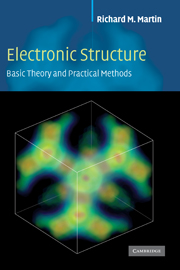Book contents
- Frontmatter
- Contents
- Preface
- Acknowledgments
- Notation
- Part I Overview and background topics
- 1 Introduction
- 2 Overview
- 3 Theoretical background
- 4 Periodic solids and electron bands
- 5 Uniform electron gas and simple metals
- Part II Density functional theory
- Part III Important preliminaries on atoms
- Part IV Determination of electronic structure: the three basic methods
- Part V Predicting properties of matter from electronic structure – recent developments
- Appendix A Functional equations
- Appendix B LSDA and GGA functionals
- Appendix C Adiabatic approximation
- Appendix D Response functions and Green's functions
- Appendix E Dielectric functions and optical properties
- Appendix F Coulomb interactions in extended systems
- Appendix G Stress from electronic structure
- Appendix H Energy and stress densities
- Appendix I Alternative force expressions
- Appendix J Scattering and phase shifts
- Appendix K Useful relations and formulas
- Appendix L Numerical methods
- Appendix M Iterative methods in electronic structure
- Appendix N Code for empirical pseudopotential and tight-binding
- Appendix O Units and conversion factors
- References
- Index
4 - Periodic solids and electron bands
from Part I - Overview and background topics
Published online by Cambridge University Press: 05 June 2012
- Frontmatter
- Contents
- Preface
- Acknowledgments
- Notation
- Part I Overview and background topics
- 1 Introduction
- 2 Overview
- 3 Theoretical background
- 4 Periodic solids and electron bands
- 5 Uniform electron gas and simple metals
- Part II Density functional theory
- Part III Important preliminaries on atoms
- Part IV Determination of electronic structure: the three basic methods
- Part V Predicting properties of matter from electronic structure – recent developments
- Appendix A Functional equations
- Appendix B LSDA and GGA functionals
- Appendix C Adiabatic approximation
- Appendix D Response functions and Green's functions
- Appendix E Dielectric functions and optical properties
- Appendix F Coulomb interactions in extended systems
- Appendix G Stress from electronic structure
- Appendix H Energy and stress densities
- Appendix I Alternative force expressions
- Appendix J Scattering and phase shifts
- Appendix K Useful relations and formulas
- Appendix L Numerical methods
- Appendix M Iterative methods in electronic structure
- Appendix N Code for empirical pseudopotential and tight-binding
- Appendix O Units and conversion factors
- References
- Index
Summary
Summary
Classification of crystals and their excitations by symmetry is a general approach applicable to electronic states, vibrational states, and other properties. The first part of this chapter deals with translational symmetry which has the same universal form in all crystals, and which leads to the Bloch theorem that rigorously classifies excitations by their crystal momentum. (The discussion here follows Ashcroft and Mermin, [84], Chs. 4–8.) The other relevant symmetries are time reversal and point symmetries. The latter depend upon a specific crystal structure and are treated only briefly. Detailed classification can be found in many texts, and computer programs that deal with the symmetries can be found on-line at sites listed in Ch. 24.
Structures of crystals: lattice + basis
A crystal is an ordered state of matter in which the positions of the nuclei (and consequently all properties) are repeated periodically in space. It is completely specified by the types and positions of the nuclei in one repeat unit (primitive unit cell), and the rules that describe the repetition (translations).
• The positions and types of atoms in the primitive cell are called the basis. The set of translations, which generates the entire periodic crystal by repeating the basis, is a lattice of points in space called the Bravais lattice. Specification of the crystal can be summarized as:
Crystal structure = Bravais lattice + basis.
- Type
- Chapter
- Information
- Electronic StructureBasic Theory and Practical Methods, pp. 73 - 99Publisher: Cambridge University PressPrint publication year: 2004
- 1
- Cited by



